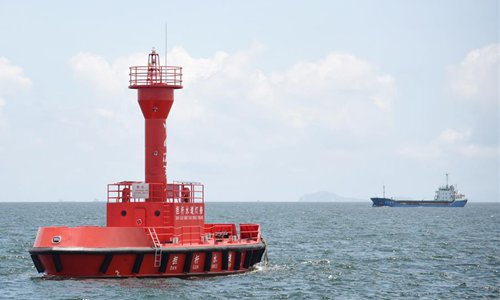
A lightship which uses the BeiDou Satellite Navigation System is deployed in the Lema Channel on the Pearl River estuary in south China's Guangdong Province, June 20, 2019. The Lema Channel lies to the south of the Hong Kong Island and serves as an important waterway in the eastern part of the Guangdong-Hong Kong-Macao Greater Bay Area. (Xinhua/Tian Jianchuan)
The Greater Bay Area (GBA) in South China is joining hands to catch up with other domestic regions in scientific research, matching Hong Kong's science talent with Shenzhen's policy support and booming business environment.Experts also called for cities in the area to bring their strengths into full play in scientific cooperation, suggesting that Macao play a greater role in the application of fintech research.
Among cities in the area, Shenzhen has an advantage in capital support to scientific research, both from the government and social entities. According to a statement released by the Shenzhen Science and Technology Innovation Committee, Shenzhen is planning to provide financial aid of 110 million yuan ($15.7 million) to 22 local-based scientific laboratories. Each laboratory will receive 5 million yuan.
Those laboratories conduct work on a broad spectrum of research topics ranging from cellular immune regulation to marine microorganisms, the statement showed.
The Shenzhen government tries to catch up with other cities in the GBA in basic scientific research, said Liu Guohong, director of the Department of Finance and Modern Industries at the China Development Institute.
"Basic scientific research has become Shenzhen's ' Achilles' heel ' despite its innovative business environment that gave birth to high-tech enterprises like Huawei and DJI. It can no longer rely on any means except independent innovation," Liu told the Global Times on Thursday.
The GBA in general also lags behind in scientific research, experts said. "Currently, the scientific papers published in Shenzhen, Guangzhou and Hong Kong in total are fewer than those published in Shanghai," Liu said.
There are 32 key national laboratories in Shanghai and 20 in East China's Jiangsu, while there are only 11 in Guangdong, according to a report published from the Ministry of Science and Technology.
To achieve a leap in scientific research, cities in the GBA, particularly Hong Kong and Shenzhen, are strengthening trans-regional cooperation. For example, of the 22 laboratories in Shenzhen, two were set up by the branch campus of the Chinese University of Hong Kong in Shenzhen.
"Many Hong Kong universities are attracted to set up scientific laboratories and institutions in Shenzhen for the latter's rich business resources such as venture capital that can back those academic projects," Yeung Kwan-ho, a research fellow of the Chinese University of Hong Kong, told the Global Times on Thursday.
But he stressed that such cooperation should progress further and cities in the area should bring their strengths into full play in scientific cooperation.
"Hong Kong can contribute talent because of its advantage in research capabilities and its international talent pool. Shenzhen has an advantage in its land resources and its active business environment, which provide fertile soil for the application of scientific research results. Macao is developing fast in finance and therefore can cooperate with other cities in the application of fintech," Yang said.
He also called for the establishment of an ecosystem, led by government authorities in Guangdong, to facilitate communication and cooperation among government officials, businesses, and research institutions like colleges and think tanks in the GBA.


